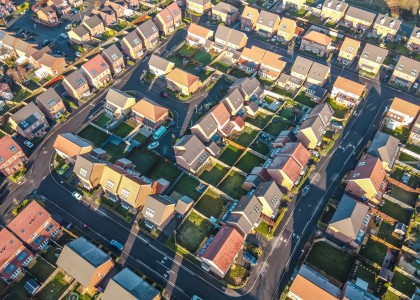This report was updated on April 23, 2025 to include utility bill fuel charges that were omitted from the original version. Further details on the revisions are available in our blog post.
Key findings
|
Electricity rates that keep bills down after home heating electrification with heat pumps
Electrification is the process of replacing fossil fuel–based technologies or systems with electric equivalents. With the U.S. electricity grid currently supplied by 40% zero-carbon sources and this percentage increasing, electrification is a key part of greenhouse gas emissions reductions and climate change mitigation. However, households are unlikely to electrify their homes if their energy bills will increase (or if they believe their energy bills will increase). In this report, we focus on post-electrification energy bills, but upfront costs are also an important barrier to electrification that should be addressed.
In cold climates, once a home is electrified, its biggest electricity use in the home is space heating. We simulate energy bills in four regions of cold-climate U.S. states (using actual utility rates in those regions) under different home heating electrification scenarios and provide recommendations for policies and programs in those states to mitigate potential cost increases. The four states are among the most expensive in the United States for electrification and differ from most of the United States, where electrification is generally cost effective. We examine energy efficiency, electricity rates, fossil fuel rates, and novel financial strategies as potential solutions to mitigate energy bill increases. To encourage adoption, we suggest how to roll out solutions with the help of behavioral science principles.
Heat pumps always reduce energy bills for oil and propane users; can do so for natural gas with better rates
In our simulations of annual energy bills in four cold-climate states, customers who were previously using fuel oil or propane for space heating saw, on average, noticeably lower bills when installing an efficient cold-climate heat pump. Although this finding is based on our simulations of four states, given similarities in rates and contexts, it likely applies to fuel oil and propane users across all or most cold-climate U.S. states (17% of fossil fuel–heated homes in these states). However, in all four states we examined with very high electricity prices relative to natural gas prices, the average gas household saw energy bills increase after home heating electrification. We examined how rate structure changes, efficiency improvements, and broader policy changes and investments could help keep energy bills down in these states.
In particular, we simulated energy bills of single detached residential buildings in regions of Minnesota, Colorado, Maine, and Connecticut, before and after electrification of home heating with efficient cold-climate heat pumps (using actual utility rates in those regions as a base). We examined how bills might change in these states if energy efficiency envelope and appliance upgrades were included with electrification and if the home were on various electricity rate plans.
Ensuring electrification does not increase energy bills
In any cold-climate U.S. state, the ongoing bills are lowest with cold-climate heat pumps when heat pump adoption is accompanied by energy efficiency improvements and a favorable electricity rate plan. Heat pump-specific rate plans are best for incentivizing heat pump adoption, with winter discounts being a potentially important facet of those plans. These rates are generally based on the cost of service for heat pump customers, without subsidizing other customer classes. Given homes with heat pumps use more electricity, particularly during off-peak periods, the cost of servicing these homes is different, as more of their use is during periods of lower grid strain. In absence of these types of rates (e.g., in places where technology-focused rates are not an option), time-of-use rates, demand-based rates, and simpler winter discount rates also favor heat pump adoption. In nearly all cases, these rates are revenue neutral for the utility’s current customer base; however, they also have the added benefit of attracting new load and increasing electricity use (thus increasing overall revenues and helping to offset any potential revenue losses when rates are not revenue neutral).
The various potential solutions can be seen in our state-specific analyses. In Minnesota, the utility we examined (serving approximately half of residential customers) offers a 31% winter discount for electricity that can be combined with a time of use rate (available to all electrically heated homes served by that utility). After whole-home electrification and building envelope improvements, average energy bills decrease from $2,680 with natural gas heat to $2,591 under the winter discount TOU rate. If the utility offered a winter discount demand-based rate, annual energy bills could drop further; an average of $2,576. With only heat pump and insulation (no additional electrification), energy bills of homes under a winter discount demand-based rate are still similar to those of natural gas-heated homes ($2,719/year).
In Colorado, the winter discount of the utility we examined (serving just over half of residential customers) is much smaller (~10%), so switching from natural gas to an efficient cold-climate heat pump would, on average, increase annual energy bills for single family homes. However, if the utility offered the Minnesota-level winter discount and TOU rate, then homes installing a heat pump alongside envelope upgrades would see energy bills like those of natural gas-heated homes ($1,941/year for gas, versus $1,975/year for heat pump customers). Adding whole-home electrification measures or pairing the winter discount with a demand-based rate (rather than TOU rate) could potentially reduce energy bills below that of natural gas users’ bills (as it does in Minnesota), but this would require verification through additional analyses.
In Maine and Connecticut, fuel oil and propane customers (representing a combined 41% of homes in Connecticut and 66% of homes in Maine in 2023) can save money through electrification. However, natural gas users switching to a heat pump for electrification would see bills increase. The ratio of electricity to gas price is too high to be overcome with rate structure or efficiency changes in these states. Here, as in other states where electricity is much more expensive than gas, the states should consider deep public investment (not ratepayer-funded) in making electric power more affordable to their residents. This could include taking on some costs of grid maintenance and upgrades, putting a price on carbon, or implementing clean heat standards that place performance requirements on all heating market actors. Fortunately, this high an electricity-gas price ratio is rare and gas prices are expected to naturally increase in the coming years relative to electricity.
Behavioral strategies supporting residential electrification
Despite energy bills staying the same or going down after electrification, nonfinancial barriers may still pose a challenge to electrification. Behavioral strategies can be used to enhance the energy savings messaging. The biggest barrier to electrification of home heating is a lack of awareness: awareness of heat pumps as an option for fossil fuel–heated homes and awareness that electric home heating could occur without increasing bills. To increase awareness, a traditional marketing and outreach campaign could be helpful. Providing the information through traditional media, social media, mailers, bill inserts, or in-person events is effective for educating customers.
HVAC contractors can also be a key barrier to heat pump adoption. Contractors have misperceptions about the efficiency and costs of heat pumps: They see them as complex, and they believe the installation would be complicated and difficult. They feel pressured to complete jobs quickly and thus avoid lengthy discussions or challenging installations. Embedding more in-depth heat pump information in HVAC training courses, providing incentives to contractors, encouraging effective discussions with homeowners, and supporting a shift from getting jobs done quickly to maximizing homeowners’ long-term satisfaction can help with electrification initiatives.
Changing default rate plans for customers who electrify can be an effective strategy, but it must be done carefully, with great transparency and with repeated communication and outreach so as not to erode trust. Engendering trust with utilities offering electrification packages is critical to encouraging uptake. Trust is facilitated with transparent communications and community engagement that may take the form of working with local community-based organizations (e.g., housing counselors, neighborhood groups, local community leaders, or religious and cultural groups).
Recommendations
Electric Utilities and State Regulators: Provide electricity rates that favor heat pumps while still adhering to cost of service principles. Heat pump–specific rates are best for encouraging heat pump adoption. Winter discounts are critical and time-of-use rates or demand-based rates can also benefit electrification of home heating.
Federal and State Policymakers: Consider providing some public (non-ratepayer) investment in electricity distribution and transmission, put a price on carbon, and/or implement clean heat standards.
Program Administrators and Implementers: Use behavioral strategies to encourage electrification and shift consumption patterns. Raise awareness of heat pump electrification as an option for home heating and show how costs compare to other options. Work with contractors to dispel myths, provide training, and empower discussions about electric heating with customers.
Download the report
| Suggested Citation |
| Malinowski, Matt, Reuven Sussman, Paul Mooney and Grace Lewallen. 2025. Electricity Rates That Keep Bills Down after Electrification of Home Heating. Washington, DC: ACEEE. www.aceee.org/research-report/b2502. |






